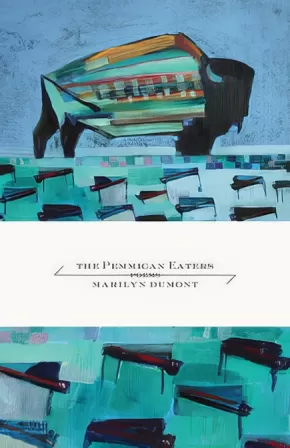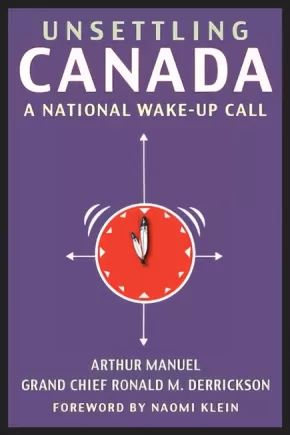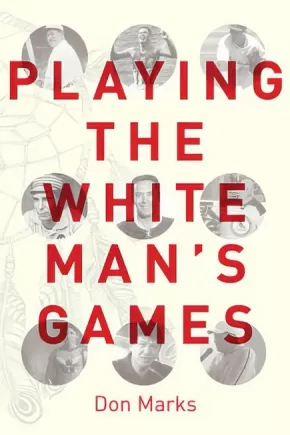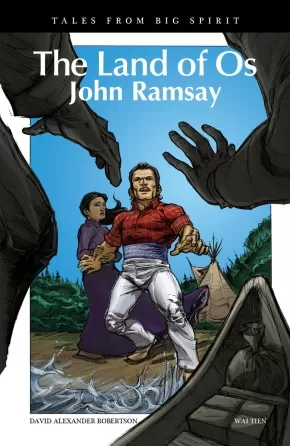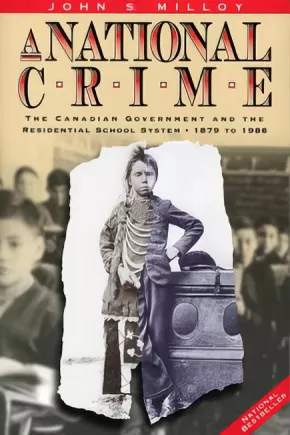Canadian Indigenous Books for Schools 8 - 12 2017-2018
Synopsis:
A picture of the Riel Resistance from one of Canada’s preeminent Métis poets.
With a title derived from John A. Macdonald’s moniker for the Métis, The Pemmican Eaters explores Marilyn Dumont’s sense of history as the dynamic present. Combining free verse and metered poems, her latest collection aims to recreate a palpable sense of the Riel Resistance period and evoke the geographical, linguistic/cultural, and political situation of Batoche during this time through the eyes of those who experienced the battles, as well as through the eyes of Gabriel and Madeleine Dumont and Louis Riel.
Included in this collection are poems about the bison, seed beadwork, and the Red River Cart, and some poems employ elements of the Michif language, which, along with French and Cree, was spoken by Dumont’s ancestors. In Dumont’s The Pemmican Eaters, a multiplicity of identities is a strengthening rather than a weakening or diluting force in culture.
Awards
- Winner of the 2016 Stephan G. Stephansson Award for Poetry
Reviews
“A rollicking poem about the fiddle ('the first high call of the fiddle bids us dance/baits with its first pluck and saw of the bow/reels us, feet flick — fins to its lure and line') becomes a statement of cultural pride and defiance — much like The Pemmican Eaters as a whole.” — Toronto Star
“Dumont’s work is visual and evocative, highlighting recurring symbols and images of a natural world that will be familiar to any dweller of the Prairies . . . The Pemmican Eaters builds off the poet’s earlier work and highlights a writer who has mastered both craft and voice.” — Quill & Quire
“Dumont honours Métis traditions in music and beadwork in a number of lyrically driven poems. The Pemmican Eaters is a statement of cultural pride and defiance, much like Marilyn herself.” — CBC News Online
“Marilyn Dumont uses both rhythmic and free verse to provide a brilliant and insightful look at Métis and Cree people.” — Scene Magazine
Educator Information
This book would be useful for grades 9 - 12 in courses such as creative writing, English language arts, and social studies. Also recommended for students a college/university level.
Additional Information
96 pages | 5.50" x 8.50"
Synopsis:
Unsettling Canada, a Canadian bestseller, is built on a unique collaboration between two First Nations leaders, Arthur Manuel and Grand Chief Ron Derrickson.
Both men have served as chiefs of their bands in the B.C. interior and both have gone on to establish important national and international reputations. But the differences between them are in many ways even more interesting. Arthur Manuel is one of the most forceful advocates for Aboriginal title and rights in Canada and comes from the activist wing of the movement. Grand Chief Ron Derrickson is one of the most successful Indigenous businessmen in the country.
Together the Secwepemc activist intellectual and the Syilx (Okanagan) businessman bring a fresh perspective and new ideas to Canada’s most glaring piece of unfinished business: the place of Indigenous peoples within the country’s political and economic space. The story is told through Arthur’s voice but he traces both of their individual struggles against the colonialist and often racist structures that have been erected to keep Indigenous peoples in their place in Canada.
In the final chapters and in the Grand Chief’s afterword, they not only set out a plan for a new sustainable indigenous economy, but lay out a roadmap for getting there.
Reviews
“This is the back story of both grassroots and backroom struggles that created the context in which we find ourselves today, one in which a new generation of First Nations leaders is demanding sovereignty and self-determination, and more and more non-Indigenous Canadians finally understand that huge swaths of this country we call Canada is not ours - or our government's - to sell.” — Naomi Klein, from the Foreword
“Pragmatic and helpful, this is a timely book for our fraught and political moment” — Quill & Quire
"Unsettling Canada is a breathtakingly beautiful story of Indigenous resistance, strength, and movement building. Unsettling Canada echoes the power of George Manuel's The Fourth World, centering the heart of the narrative deep inside a kind of Indigenous intelligence rarely shared outside our communities. This is the critical conversation that Canada and Indigenous peoples must have because it is centred on land, and, therefore, it is one of the most important books on Indigenous politics I've ever read." — Leanne Betasamosake Simpson, author of Dancing on Our Turtle's Back
Educator Information
This resource would be useful for courses in history, social justice, political science, and social studies. Recommended for students in grades 10 to 12 or those at a college/university level.
CONTENTS
Foreword Naomi Klein
Chapter 1 The Lay of the Land
Chapter 2 Institutionalizing a People: Indian Hospital, School, Jail
Chapter 3 White Paper to Red Paper: Drawing the Battle Lines
Chapter 4 Occupy Indian Affairs: Native Youth in Action
Chapter 5 Aboriginal Title: No Surrender
Chapter 6 The Constitution Express: A Grassroots Movement
Chapter 7 Don’t Let Them Bully You: A Business Interlude
Chapter 8 A Chief’s Concerns: Finances, the People, and the Land
Chapter 9 Upping the Ante: RCAP and a Landmark Court Decision
Chapter 10 The Battle in the Forest: The Trade in Indian Trees
Chapter 11 Sun Peaks to Geneva: Playgrounds and Fortresses
Chapter 12 Taking It to the Bank: Accounting for Unpaid Debt
Chapter 13 The Fourth World: A Global Movement
Chapter 14 Line of Defence: Side by Side for Mother Earth
Chapter 15 No Half Measures: The Price of Uncertainty
Chapter 16 Days of Protest: Young Activists Come Together
Chapter 17 The End of Colonialism
Afterword Grand Chief Ronald M. Derrickson
Acknowledgements
Appendix United Nations Declaration on the Rights of Indigenous Peoples
Notes
Index
Additional Information
288 pages | 6.00" x 9.00"
Synopsis:
A Canadian bestseller and winner of the 2016 Canadian Historical Association Aboriginal History Book Prize, Unsettling Canada is a landmark text built on a unique collaboration between two First Nations leaders.
Arthur Manuel (1951-2017) was one of the most forceful advocates for Indigenous title and rights in Canada; Grand Chief Ron Derrickson, one of the most successful Indigenous businessmen in the country. Together, they bring a fresh perspective and bold new ideas to Canada's most glaring piece of unfinished business: the place of Indigenous peoples within the country's political and economic space.
This vital second edition features a foreword by award-winning activist Naomi Klein and an all-new chapter co-authored by law professor Nicole Schabus and Manuel's son, Ska7cis, honouring the multi-generational legacy of the Manuel family's work.
Reviews
“Pragmatic and helpful, this is a timely book for our fraught and political moment” — Quill & Quire
"Unsettling Canada is a breathtakingly beautiful story of Indigenous resistance, strength, and movement building. Unsettling Canada echoes the power of George Manuel's The Fourth World, centering the heart of the narrative deep inside a kind of Indigenous intelligence rarely shared outside our communities. This is the critical conversation that Canada and Indigenous peoples must have because it is centred on land, and, therefore, it is one of the most important books on Indigenous politics I've ever read." — Leanne Betasamosake Simpson, author of Dancing on Our Turtle's Back
Educator Information
This resource would be useful for courses in history, social justice, political science, and social studies. Recommended for students in grades 10 to 12 or those at a college/university level.
Additional Information
320 pages | 6.00" x 9.00"
Synopsis:
Playing the White Man's Games tells the extraordinary tales of Native American athletes who overcame tremendous obstacles to dominate the NFL, CFL, PGA, Olympic Games, NHL and professional wrestling. From ABC's "Athlete of the Century" Jim Thorpe, whose track and field career began when he surpassed his college varsity high jump team in street shoes and climaxed with gold medals in the decathlon and pentathlon at the 1912 Olympic Games, before moving on to dominate NCAA and NFL football, major league baseball and 22 sports in all, including a national championship in ballroom dancing. To Billy Mills, who improved his best time by an unheard of 50 seconds to win the 10,000-metre Olympic race in "the greatest upset in Olympic history." And Notah Begay III, a product of public courses and Navajo code talkers who won four PGA tournaments in his first two years on the pro golf tour. Sometimes referred to as the "forgotten American", the fascinating stories of these colourful characters will make you recall Native American heroes with wonder and awe, not only for their exploits on the field of play, but for their efforts to preserve and enhance native history, culture and lifestyle with pride and dignity away from the competition.
Additional Information
272 pages | 6.00" x 9.00"
Synopsis:
When Richard’s class from Big Spirit School takes a canoe trip, he and his classmates chance upon an elderly woman. She tells them the story of her grandfather, John Ramsay, of the Sandy Bar community on Lake Winnipeg. Ramsay’s land was taken by the government and given to the new settlers from Iceland who arrived there in 1875. Yet many owed their survival to Ramsay, who helped them through freezing winters, hunger, and a devastating smallpox epidemic.
Educator & Series Information
The Land of Os is one book in the Tales From Big Spirit series. Tales from Big Spirit is a unique graphic novel series that delves into the stories of great Indigenous heroes from Canadian history—some already well known and others who deserve to be. Designed to correspond to grades 4–6 social studies curriculums across Canada, these full colour graphic novels could be used in literature circles, novel studies, and book clubs to facilitate discussion of social studies topics. These books will help students make historical connections while promoting important literacy skills.
A Teacher's Guide is also available for the Tales from the Big Spirit Series: Tales from the Big Spirit Series Teacher's Guide. The teacher's guide is designed to help classroom teachers use the graphic novel series, Tales From Big Spirit, by David Alexander Robertson. The guide provides detailed lessons that meet a wide range of language arts and social studies goals, integrate Indigenous perspectives, and make curricular content more accessible to diverse learners.
This resources is also available in French: D'hier à aujourd'hui, Le protecteur d’Ós : John Ramsay
Additional Information
30 pages | 6.50" x 10.00"
Synopsis:
“I am going to tell you how we are treated. I am always hungry.” — Edward B., a student at Onion Lake School (1923)
“[I]f I were appointed by the Dominion Government for the express purpose of spreading tuberculosis, there is nothing finer in existence than the average Indian residential school.” — N. Walker, Indian Affairs Superintendent (1948)
For over 100 years, thousands of Aboriginal children passed through the Canadian residential school system. Begun in the 1870s, it was intended, in the words of government officials, to bring these children into the “circle of civilization,” the results, however, were far different. More often, the schools provided an inferior education in an atmosphere of neglect, disease, and often abuse.
Using previously unreleased government documents, historian John S. Milloy provides a full picture of the history and reality of the residential school system. He begins by tracing the ideological roots of the system, and follows the paper trail of internal memoranda, reports from field inspectors, and letters of complaint. In the early decades, the system grew without planning or restraint. Despite numerous critical commissions and reports, it persisted into the 1970s, when it transformed itself into a social welfare system without improving conditions for its thousands of wards. A National Crime shows that the residential system was chronically underfunded and often mismanaged, and documents in detail and how this affected the health, education, and well-being of entire generations of Aboriginal children.
Additional Information
424 pages | 6.00" x 9.00"

